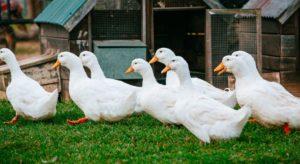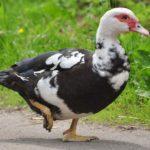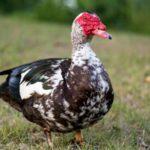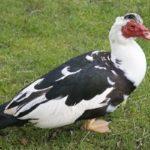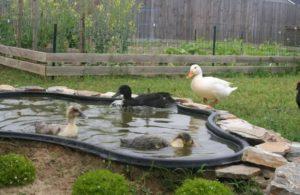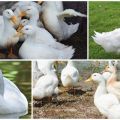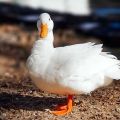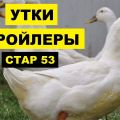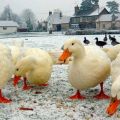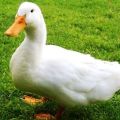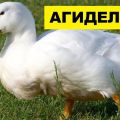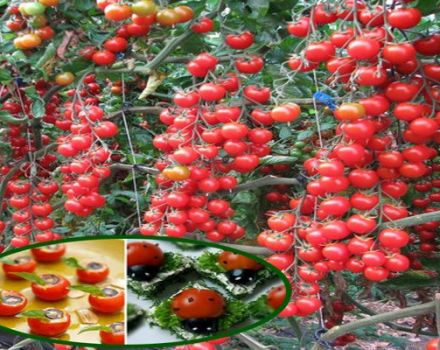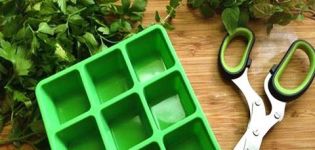Description of musky ducks, their pros and cons and breeding rules
In addition to common ducks, muscovy ducks can be found in poultry farms. They are popularly called Indo-women because of growths on the head that resemble turkey ones. In addition to this trait, they have other differences in characteristics from ordinary ducks. Consider the description and characteristics of musky ducks, varieties, pros and cons, rules of keeping, feeding and breeding.
History of the origin of the breed
The name "Indo-duck" for musky ducks was invented for a reason. They really are somewhat reminiscent of turkeys, but have nothing to do with them. It is not a hybrid of 2 bird species as some people think. It is a distinct species of duck native to South America. Before they were domesticated, they lived there in the forests, along the banks of tropical rivers.
Muscovy ducks were exported from South America to Europe and other countries. At first they were kept in parks as an exotic bird, along with swans and peacocks, and then as an ordinary farm bird.
General description and characteristics
The body of musk ducks is long and wide, the neck and legs are short. The wings are developed, feathers are long, which allows the bird to fly. On the sides of the head in drakes and females there are red growths that secrete fat with a faint musk odor. In males, they are larger than in females. Because of these outgrowths, the Indo-duck's head looks like a turkey.
The species belongs to wood ducks, therefore, unlike domestic ducks, descended from mallards, does not need reservoirs, but swims well. By nature, they are calm and clean, do not run around the yard, do not arrange a swamp. Not quacking, but quietly hissing.
The plumage color is white, black with greenery, black and white, brown, tortie, smoky. Both males and females of the same breed are colored the same, they can be distinguished by the size of the body and growths. The weight of an adult duck is 2.5 kg, drakes are larger - 3.2-3.5 kg (maximum - 5 kg). Little ducklings are raised for meat up to 2.5-3 months. During the season, one bird can lay 12 dozen eggs, 75 g each.

Varieties of muscovy ducks
The coloration that musk ducks have in nature is black, interspersed with white areas on the head, neck and throughout the body. The rest of the colors were bred by humans. In birds with white plumage, the eyes are also light, gray-blue. Scarlet growths. Down of ducklings is yellow, white plumage appears after the first molt.
H
The feathers of the corresponding color are chocolate or brown. There are inclusions of white feathers, from single specimens to white patches on the neck and head. The legs and beak are red, the eyes are brown. Down of ducklings is light brown.
Blue musky ducks have a gray-blue plumage. White patches are present on the sides and wings. The paws are dark gray, the eyes are brown, the growths are red. Down of ducklings is gray. Regardless of the color, the musky ducks breed belongs to the meat direction.
Positive and negative sides
As you can see, Indo-girls have more pluses than minuses.
Conditions of detention and care
Muscovy ducks can be kept with common and other birds. For living, they can equip any building in which it will be warm in winter and cool in summer. In it, the birds should be comfortable, spacious, they do not like to live in cramped conditions.
They don't like dampness either, so the duck house needs to be ventilated every day so that excess moisture goes away and the air clears.
The conditions for growing muscovy ducks allow you to do without a reservoir. However, it is imperative to walk the bird, and not keep it locked up. Movement and sunlight have a beneficial effect on the body, ducks grow better, begin laying eggs faster, and the number of laid eggs increases.
Muscovy ducks are arboreal, therefore, like chickens, they like to sit on elevations. In the poultry house, wide beams can be installed for them not far from the floor, at a distance of about 15 cm. The Indo-girls will rest on them.

Below, on the floor, a litter of straw, peat, shavings is lined. As soon as it gets dirty, it needs to be replaced. At least 2 times a year, the entire room must be disinfected, drinkers and feeders - every month. Processing reduces the likelihood of infection by bacteria and viruses, the subsequent development of diseases.
What to feed?
Muscovy ducks love green food more than ordinary ducks. If possible, they should be allowed to graze. By walking on pasture in the summer, feed costs can be cut in half. The main diet of Indo-Ducks is a grain mixture or porridge made from cereals, boiled vegetables and root crops, and potatoes. As additives, you can add fish and meat and bone meal, feed yeast, salt, chalk to them. Indo-duck can be grown on compound feed specially developed for them. Musk grows quickly, but slower in relation to ordinary ducks.
In winter, adult birds can be fed (per head) with a mixture consisting of 30 g of crushed corn, 20 g of wheat grains, 50 g of barley, 40 g of oats, 15 g of oil cake, 20 g of bran and millet. Add raw root vegetables grated on a coarse grater to the grain, herbal chaff, shell, salt, yeast, fish meal and cottage cheese.
Before egg-laying, muscovy ducks need to be fed vigorously, increasing the number of feedings up to 4 times a day. Usually, 3 times a day is enough. In addition to the frequency, you need to observe the feeding regime, that is, give food at the same time, to which the birds get used. Along with the feed, you need to change the water in the drinkers. Ducks can scatter feed, so the trough should be no more than half full.
Breeding rules
Parent pairs should be composed of 1 drake and 2-3 ducks. To obtain musk ducklings, purebred parents are selected. If you cross an Indo-duck with a Peking one, you get mulard hybrids. They surpass their parents in all respects - they are larger, grow faster, run better, live longer.
The term of development in a duckling egg is 28 days. The eggs can be hatched by the duck itself, the chicken or the turkey. If you have a home incubator, hatching will be artificial. With natural breeding, ducklings can be left with their mother, but they can be planted separately from other birds so that they do not accidentally injure them. If the ducklings are hatched in an incubator, they are raised in a brooder for a month. The temperature and humidity conditions are set in it - 25-30 ˚С and humidity 60-70%. Ducklings under one month old should not get into water bodies, they have not yet developed the secretion of fat with which birds lubricate their feathers.
It is necessary to feed homemade musk ducklings with boiled crumbly cereals with the addition of herbs, grated vegetables, milk powder. By 2 months, the chicks reach a weight of 2 kg. If you need to get fatty meat, feeding continues for up to 5 months.

Ducks fly well up to 3 years of age. Then they need to be replaced with young ones. A good adult laying hen can be recognized by a soft and voluminous belly, a wide cloaca, widely spaced flexible pubic bones, smooth and clean feathers.
Possible diseases
Diseases that can affect muscovy ducks are divided into 3 groups: infectious, non-infectious and parasitic. The cause of infections is poor care of the bird, unsystematic cleaning of the premises, feeders and drinkers, cleaning and disinfection of equipment. Bacteria and viruses enter the bird's body through contact with dirty bedding, food and drink from dirty feeders and drinkers.
Parasitic diseases also develop from the owner's failure to comply with the conditions of detention, cleanliness in the poultry house. Muscovy ducks become infected with parasites through contact with sick birds. Any disease can be avoided or the likelihood of its development reduced if the house is cleaned and the room and equipment kept clean. Diseases of digestion and metabolism are prevented by the preparation of the correct diet, timely feeding of muscovy ducks, and giving food in the required amount.
How long do they live?
Wild ducks live 8-12 years. This is the maximum life span; in reality, many die earlier from diseases or predators. Domestic animals raised for meat live up to 3-6 months. Laying hens are left for 3 years, then they are also sent for meat. Tribal drakes can be used for up to 5 years, then they are also changed.
But, if you do not take into account that ducks are used for household needs, then life in the poultry yard is preferable for them than in the wild. If you leave the duck as a pet, it can live as long as possible.
Muscovy ducks are larger than usual and have lean meat. Calm, no noise and no need for a reservoir. These are the main advantages due to which they have become popular with domestic poultry farmers. Despite the difference from ordinary ducks, they can be kept and fed in the same way.
